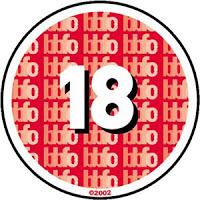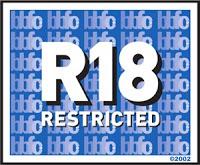 It was the blight of many a childhood (and certainly still is)
It was the blight of many a childhood (and certainly still is)"A ticket for that film, please."
"How old are you?"
"Eleven years, nine months and three days."
"Sorry, come back when you're twelve."
Those nine months and three days were so important to you, because each month and day that was added to your age, was another month and day closer to when we could go see that 12-rated film at the Cinema. And then, the moment we hit twelve, it was the ultimate countdown to turning fifteen, and finally eighteen. When you hit eighteen, it feels like the world is your oyster because you can quite literally see any film that you want. But, then when you hit eighteen years and one minute old, well that's when you want to watch PG-rated films isn't it, and you wonder what all the fuss was about with these higher-rated films.
It's true that film classifications play a role in all of our lives, but I don't know about you guys, but I have very little knowledge about the organisation that actually makes decisions on what is suitable viewing. I know that they do it, I know that they often get a raw deal regarding some of their decision-making, and I know that they have apparently been doing it for an almighty 100 years, but who are they really?
Over the course of 100 years, Cinema has changed considerably. We've moved from Silent Era to Talkies, from Black and White to Colour, from Cell-Animation to CGI, from smoke and mirrors to computer trickery, and the BBFC has been there almost every step of the way. They have seen it all, and they have rated every single one of those films.
What is the BBFC?
BBFC actually stands for British Board of Film Classification, and what they do is quite simply: They classify all films that are put forward for public viewing. Literally every film that is available in cinemas, or on DVD and Blu Ray must go before a panel of experts who will judge the suitability in terms of violence, sexuality, drug-use and many other crucial factors.
The idea behind the Board has always been to create a sense of "uniformity" that would simplify the system, and that would be used "universally".
Although established in 1912, it wasn't until 1984 that they began rating films other than for Cinema viewing. In 1984, they began rating films for videos, which has of course transformed with the change of technology, to include DVDs and Blu Ray.
It should also be pointed out that the BBFC is a "Not for Profit" organisation, meaning that any money that they do make must go straight back into paying the costs required for undertaking their role.
Who classifies films, and how do they do it?
Typically, two people known as "Examiners" are the ones who will classify a film, using the BBFC's published Guidelines. Typically, these guidelines are particularly strict, as they are used to protect children from viewing media that is deemed unsuitable for them. Normally, their decision will be approved by the "Senior Examiner", however if there is any disagreement, the film may be viewed by the entire Board so that a suitable rating may be agreed upon.The BBFC works, because they are completely independent of the Film Industry. This means that they are able to be completely unbiased towards all Production Companies, Directors, film genres etc.
You can view the Guidelines that the BBFC use, in full, by downloading them here.
How are Categories decided?
There are currently six basic classifications used by the BBFC, although only five are really used widely. Various factors may determine which classification a film will be given, but as a general rule, the following are stated:

Meaning "Universal", a "U"-rated film is considered suitable for everyone. These films are deemed not to be upsetting even for small children, whilst containing no violence, threat, drug-use, sexual content, discrimination, inappropriate language or horror.
Whilst typically used for films aimed at pre-school children, a "U" rating does not necessarily mean that it is. Indeed, many films that are considered "family" films and loved by adults just as much as children are rating "U".
 Standing for "Parental Guidance", "PG" films may be considered distressing for some young audiences. Children generally do not need to be accompanied, by an adult, to see a "PG"-rated film, and children over the age of eight years old should have no problem viewing them.
Standing for "Parental Guidance", "PG" films may be considered distressing for some young audiences. Children generally do not need to be accompanied, by an adult, to see a "PG"-rated film, and children over the age of eight years old should have no problem viewing them.Horror is typically the reason for a film to be given a "PG" rating, although it is usually minor. "PG" films also often have a small amount of minor violence. However, they will contain no drug-use, sexual content or inappropriate language (unless very minor). Most children's films tend to get this rating, and it tends to be left up to the parents to decide if they feel that their child can handle any types of horror etc, because all children mature differently.
 This rating is pretty self-explanatory, basically these films are deemed to be suitable for anyone over the age of twelve. However, over recent years, the 12-rating for Cinema use, has actually been known as a 12A. This means that anyone under the age of 12 may watch these films, but only if they are accompanied by an adult, and it is therefore to their discretion. I wish that we'd had the 12A certificate when I was a kid, it would have saved a lot of time lying to say I was 12, when I was actually 11!!
This rating is pretty self-explanatory, basically these films are deemed to be suitable for anyone over the age of twelve. However, over recent years, the 12-rating for Cinema use, has actually been known as a 12A. This means that anyone under the age of 12 may watch these films, but only if they are accompanied by an adult, and it is therefore to their discretion. I wish that we'd had the 12A certificate when I was a kid, it would have saved a lot of time lying to say I was 12, when I was actually 11!!However, despite the adult discretion of 12A films, the BBFC still consider these to be unsuitable for anyone under the age of 12, but as I mentioned with the PG-rating, kids mature at different rates, so some can handle it.
12-rated films can include drug use, but it must be infrequent, and should definitely not glamorise or encourage its use. Horror should be minimal, providing that scenes are not disturbing or prolonged. Dangerous behavior can be included, but scenes should be more hinting and not dwelled on. Acts of violence and use of weapons should not be glamorised, especially if the weapons are easy for someone to get hold of, such as knives etc. Mild bad language is allowed, and anything stronger must be kept to a minimum. Nudity is permitted, as long as it is quick, not dwelled on and probably not full-on. Sexual references are allowed.
 If you're under the age of 15, don't even try to see this film. And, even if you are 15, expect to be ID'd, especially when you're trying to buy a DVD, even though most 15 year olds don't have ID yet (trust me, I've been there. When I was 15, I had to ask my 17 year old brother to buy I Know What You Did Last Summer on video for me. The only thing that the unnamed shop - that no longer exists - would accept in terms of ID was a National Insurance Card, which you don't get until you're 16!!)
If you're under the age of 15, don't even try to see this film. And, even if you are 15, expect to be ID'd, especially when you're trying to buy a DVD, even though most 15 year olds don't have ID yet (trust me, I've been there. When I was 15, I had to ask my 17 year old brother to buy I Know What You Did Last Summer on video for me. The only thing that the unnamed shop - that no longer exists - would accept in terms of ID was a National Insurance Card, which you don't get until you're 16!!)A 15-rated film can feature drug use, as long as it is not seem to encourage or promote it. Horror can be strong, but cannot be sexual or sadistic. Dangerous behavior and violence must not dwell. Sex and nudity are allowed, but in moderation and with no elaborate detail. So basically, most things are allowed, as long as there is not detail or glamorising.
 Films that are rated as an 18 are of course not suitable for anyone below the age of 18. They are usually violent, contain a large amount of bad language, and often include nudity or sex that is more than simple references. They can glamorise drug use, as well as violence,
Films that are rated as an 18 are of course not suitable for anyone below the age of 18. They are usually violent, contain a large amount of bad language, and often include nudity or sex that is more than simple references. They can glamorise drug use, as well as violence,So basically, there are very few things that an 18-rated film cannot do, because the BBFC deems that once you hit 18, you are an adult and can therefore make up your own judgment for films like this.
These are the main ratings, that most of us will know pretty well from modern life. However, there is a sixth rating that is "higher" so-to-speak, than an 18 and I don't think that I've ever seen the logo for it, before today and I was intrigued to see that it is completely different in design and color to all others, which kinda makes sense since PG and U are completely different to 12, 15 and 18!!
 Well, no wonder I've never come across this rating before...according to the BBFC website, the R18 certificate is
Well, no wonder I've never come across this rating before...according to the BBFC website, the R18 certificate is"a special and legally restricted classification primarily for explicit works of consenting sex or strong fetish material involving by Text-Enhance"> by Text-Enhance"> by Text-Enhance">adults. Films may only be shown to adults in specially licensed cinemas, and video works may be supplied to adults only in licensed sex shops. ‘R18’ video works may not be supplied by mail order."
So, that's what the BBFC does and what everything means. Here's to another 100 years of the BBFC doing an incredible job!

